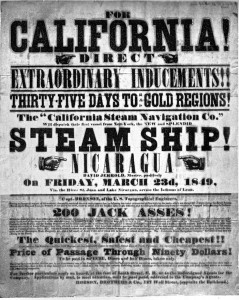 California Gold Rush-
California Gold Rush-
In early 1848, workers at John Suttter’s sawmill found flecks of gold in the American River east of Sacramento, California. By that summer news of the gold strike had reached the East and over 80,000 “forty-niners” headed to California to get rich quick.
Half of the miners traveled across the pioneer trails and the other half sailed by ship around South America.
- placer mining- used cheap metal pans, picks, and shovels to separate the gold from the sand along the banks of rivers and streams.
- hydraulic mining- used jets of water to erode gravel hills into long line of sluices to catch the gold. It did damage the environment by leveling the hills and clogging the rivers with sediment.
- hard-rock mining- was used by those with the most money to invest in the mining operation. This type of mining searched in the California mountains for veins of quartz that contained gold. The miners would get the gold in the mountains by digging tunnels and shafts that had to be drained with pumps.
Effects of the Gold Rush
- Indians and Mexicans faced discrimination
California Wanted to Quickly Become a State as the lawlessness of the 49ers was taking hold.
- Provisions of the new state constitution- excluded all African Americans, both slave and free.
- California statehood was debated bitterly in Congress because at the time there was an even number of slave and free states (15 each). Admission of California would tip the balance in the Senate.